
|
|

September 16, 2005
WAMG 890/WBIX 1060 (night), Ashland MA
By SCOTT FYBUSH
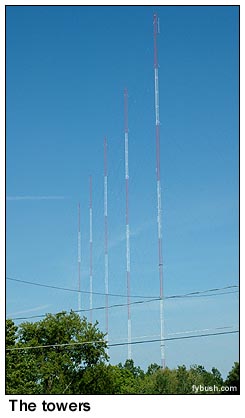 There's
something about proximity and Tower Site of the Week that has
never gone well together. Consider that in most of a lifetime
spent in Rochester, N.Y., I've still never even seen the insides
of two of the six local AM stations (both within a couple miles
of home, yet) - and that we've still never done a Site of the
Week on the Pinnacle Hill TV/FM site that dominates the dial
here from less than a mile away. (We're going to fix that soon,
we promise.)
There's
something about proximity and Tower Site of the Week that has
never gone well together. Consider that in most of a lifetime
spent in Rochester, N.Y., I've still never even seen the insides
of two of the six local AM stations (both within a couple miles
of home, yet) - and that we've still never done a Site of the
Week on the Pinnacle Hill TV/FM site that dominates the dial
here from less than a mile away. (We're going to fix that soon,
we promise.)
Even worse, we left Boston in 1997 after seven years there having visited just two of the market's AM sites. We've been fixing that, gradually, over the years in a series of visits that have resulted in features in this space on WRKO, WEEI and WBZ. And the same June trip that got us out to WBZ for the first time also brought us inside one of the market's most unusual AM facilities, the five-tower array at the end of Sewell Road in Ashland, Mass.
These five 540' towers went up around 1980 as part of some big plans for what had been a small suburban AM station in Natick, John Garabedian's WGTR (1060). The station had been around for about a decade as a kilowatt daytimer, serving its local community but not reaching out much beyond the area a competing station would soon dub "MetroWest."
Garabedian was - and is - a big thinker, and he had big hopes for his little station, building the directional array and getting a construction permit to crank the power up to 25 kW days and 2.5 kW at night.
With the power increase accomplished, WGTR went talk (as WTTP), and soon the station had an even bigger CP in hand, to increase night power to 25 kW as well. That's when the problems began: the Ashland site isn't all that far (248 miles, to be exact) from the big gun on 1060, Philadelphia's KYW, and it's quite close (28 miles) to the big gun just 30 kHz down the dial, Boston's WBZ, which was concerned about interference to its signal in the vicinity of the Ashland site. And WBZ and KYW just happened to share ownership (Westinghouse), which made it very easy for KYW's engineers to get all the data they needed to file complaints with the FCC about interference to their signal from the Natick 1060.
The bottom line: in almost a decade and a half of operation from the Ashland site, 1060 never managed to satisfy the FCC that its array had been successfully tuned up to give KYW the proper protection - and so no license to cover was ever issued for 1060 here, leaving the station (by then religious under the WBIV calls) running at half-power.
In 1994, Family Stations Inc., which was sitting on an unbuilt CP for an 890 licensed to Dedham, worked out a trade: the owners of WBIV would get the 890 CP and put it on the air from the Ashland site, while Family would get some cash and the 1060 license - but with the caveat that it couldn't operate from Ashland. The assumption in the Boston radio community was that once 890 signed on, 1060 would go dark for good. And indeed, when 890 came on the air (as WBMA) in late 1994, 1060 went silent.
(The move from 1060 to 890 brought with it a new transmitter, a Harris DX25, shown below. It replaced one of a pair of Cetec transmitters that were supposed to operate in tandem to make 25 kW for 1060. Since it operated at half-power most of its life, the two Cetecs were rarely used together. During a brief period of interim operation, WBMA/WBIV operated on 890 with the Harris by day and on 1060 with the Cetec at night; later, the Cetec was retuned to 890 for backup use.)
The cinderblock transmitter building also houses a generator and a very small room that could be used as an emergency studio, if it were a particularly dire emergency.
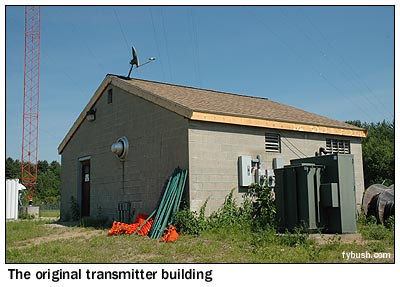 |
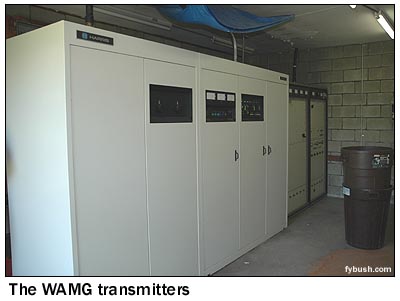 |
So the Ashland site began a new life on 890, and 1060 was given up for dead - until the arrival of Alex Langer. The Florida-based radio entrepreneur quietly bought another dark station, WRPT (1050 Peterborough NH), and then acquired the 1060 license for a pittance. And then he applied for, and was granted, two clever and interlinked moves: relocating WRPT to Ashland, Mass. as a 250-watt daytimer on 650 - and moving 1060 to the nearby site of WKOX (1200 Framingham) as a low-power daytimer.
That stopgap operation on 1060 got the station back on the air (at first doing Christian music as WJLT, "J-Light"), and bought Langer time to apply for a much bigger move: with no interference to Peterborough on 1050 to worry about (since it had moved to 650, also using the WKOX towers), 1060 was able to apply for 40 kW daytime from the WKOX site. That power increase came with new calls - WMEX, a much-traveled set of heritage Boston call letters - and a talk format that featured Jerry Williams, Gene Burns and other Boston talk veterans. But it also remained a daytimer, and in a northern city where sunset can fall not long after 4:00 in December, that remained a problem.
Then Brad Bleidt entered the picture, leasing 1060 from Langer, then buying it outright and turning it into a business station under the WBIX calls. Bleidt, a slick investment advisor, seemed to have an unending supply of money, and he used a lot of it to make the most aggressive move yet in the station's history: adding 2500 watts of night operation from, yup, the original Ashland site.
Making that happen was much more expensive than just buying a transmitter and a phasor, since the new operation was to be diplexed with the 890 Dedham signal that's now the site's primary occupant. (890 spent its first decade on the air going through several sports incarnations as WBMA and then WBPS, then went Spanish, eventually landing under Mega Communications ownership as "Mega 890," WAMG. When we visited, Mega was preparing to hand the station off to another new owner, and a few months ago it flipped to ESPN sports.)
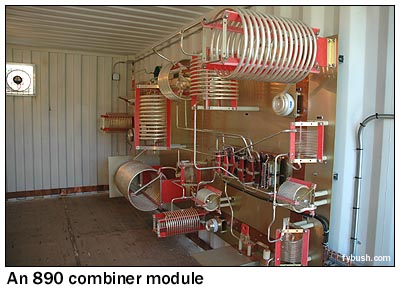 |
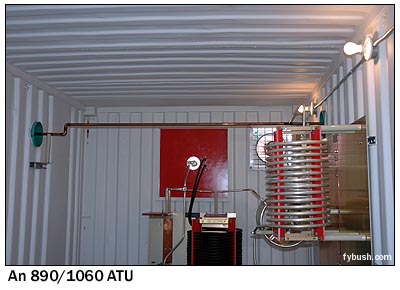 |
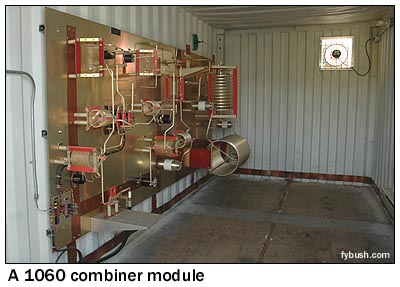 Making
the Ashland site work for both stations at night required the
rebuilding of pretty much everything between the transmitter
and the tower bases, and little expense was spared to do it right,
with the help of Phasetek, the Pennsylvania-based maker of phasors
and antenna tuning units.
Making
the Ashland site work for both stations at night required the
rebuilding of pretty much everything between the transmitter
and the tower bases, and little expense was spared to do it right,
with the help of Phasetek, the Pennsylvania-based maker of phasors
and antenna tuning units.
At the base of each tower, three containers were installed. At each tower, the leftmost container housed the combiner module for 890, incorporating a bandpass filter for 890, a reject filter for 1060 and a tuning module. The rightmost container housed the similar (but smaller) combiner module for 1060. Connecting the two in the center is the antenna tuning unit for each tower.
(Note the bus bar that runs the length of that center container, bringing in the filtered RF from each combiner module. If a third station were ever added to this site, it would be comparatively simply accomplished by extending the bus bar through one of the combiner modules to yet another container with a combiner module for the third station.)
Two more containers, placed between towers 2 and 3, hold the new phasor for 890 (also paid for by Bleidt) and the transmitter and phasor for 1060's night operation.
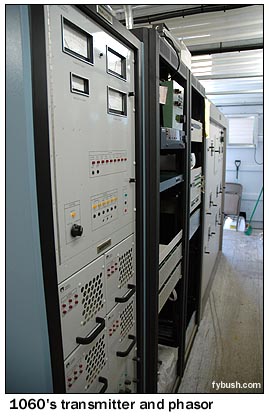 The
transmitter, shown at right, is a Nautel; the phasor, like everything
else here, is a custom Phasetek job.
The
transmitter, shown at right, is a Nautel; the phasor, like everything
else here, is a custom Phasetek job.
Construction continued at the site through much of 2004, as new transmission line was laid and the new components were installed. In the fall, Bleidt celebrated his station's new 24-hour signal with a gala party at a downtown Boston hotel.
It was, arguably, the finest moment in 1060's history - or at least it would have been, if not for the fact that the money Bleidt had used to buy, operate and upgrade the station wasn't his. Right after the party, Bleidt went out to his car and tried to kill himself, knowing that the letters he'd sent to his wife and others confessing to the crime would soon be discovered.
Bleidt ended up hospitalized and then behind bars; he recently pleaded guilty to defrauding investors of some $27 million, and he'll remain in prison for a while to come.
The station, meanwhile, entered trusteeship, continuing operations under the oversight of Alex Langer, who's doing his best to keep it going as a business talker, albeit as a less extravagant operation than it was when Bleidt was in charge.
(WBIX's lavish Boston studios have been closed, and the station now operates from the WKOX transmitter facility and former studios in Framingham, which are also home to Langer's 650, now WSRO, and to the 1060 day transmitter. That unit is a Harris MW50 that once belonged to WRKO and now sits in what used to be the WKOX garage.)
And that's the story of a most unusual facility that's packed more stories into 25 years than most transmitter sites see in a lifetime. Next week, we continue our look back at our June New England trip by heading south to Connecticut - don't miss it!
JUST RELEASED - it's your very first chance to order the 2006 Tower Site Calendar! Click here for ordering information!
- Previous Site of the Week: WATD, Marshfield MA
- Next Week: WLAT and WCCC/WTMI, New Britain/Hartford CT
- Site of the Week INDEX!
- How can you help support Site of the Week? Click here!
- Submit your suggestions for a future Site of the Week!
